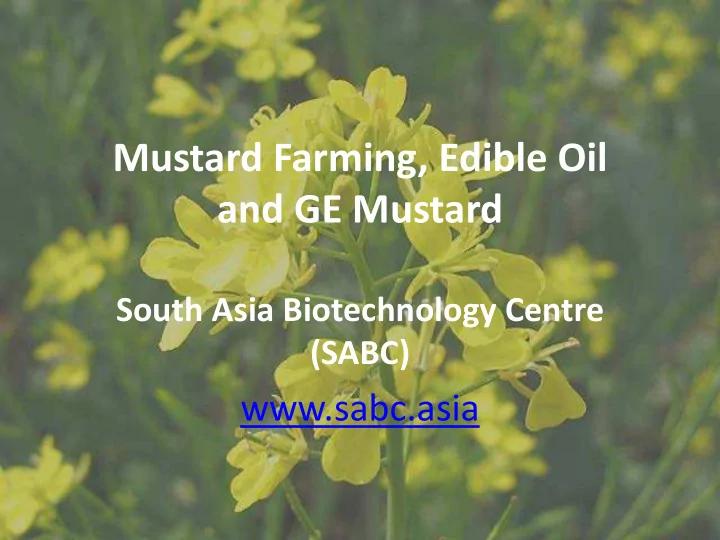

Mustard Farming, Edible Oil and GE Mustard South Asia Biotechnology Centre (SABC) www.sabc.asia
Importance of Mustard Breeding • The barnase-barstar GE mustard technology is aimed at developing efficient hybrid seed production system in widely cultivated Indian mustard (Brassica juncea) • DMH-11 hybrid, based on barnase-barstar technology, is the first public sector mustard hybrid developed by Delhi University South Campus with the funding of DBT and NDDB • In the past, the Brassica group at Delhi University South Campus identified and developed the cytoplasmic male sterility (CMS) based conventional mustard hybrid DMH-1 way back in early 2000 • Subsequently, many public and private sector institutions have developed CMS based mustard hybrids, however, constrained with various limitations associated with CMS systems Source: Analysed by SABC, 2016
The Enormity of Edible Oil Problem • 60 lakh mustard farmers grow mustard over 6.5 million ha contributing 30% of total domestic edible oil production • Indian mustard farmers suffer from very low mustard productivity as low as 1000 kg per hectare – one third of those in Canada, China and Australia • A narrow variability in mustard germplasm and multiple biotic and abiotic stresses affect potential yield realization • India is hugely edible oil deficit country and annually imports approx. 14.5 million tons of edible oil worth Rs. 78,000 crore to meet domestic requirement pegged at 20 million tons Imported edible oils comprise of palm oil, GE soybean and • GE canola oil • Indian farmers are at disadvantage viz-a-viz imported edible oil due to lack of access to innovation farm technologies Source: Analysed by SABC, 2016
Trend in Mustard Production in India, 2001 to 2015 Source: MOA&FW, 2015; Analyzed by SABC, 2016
Trend in Mustard Yield in India, 2001 to 2015 Source: MOA&FW, 2015; Analyzed by SABC, 2016
Yield Comparison of Rapeseeds- Mustard, 2014-15 Source: MOA&FW, 2015; Analyzed by SABC, 2016
Status of Commercial Approval of GE Canola ( Brassica napus ), 1996 to 2016 Trait/Stacked Gene(s)/ Nos of Developers/ Commercial Approval for Trait(s) Herbicide Approved Trade Name Approval food and Feed Events Consumption -Multiple Mode Bar, 26 -Bayer Canada; Australia; Herbicide Barnase & CropScience USA; Canada; Tolerance Barstar; -Monsanto Australia Chile; -Pollination Glyphosate; -Pioneer/ China; Control System Glufosinate Dupont European -Stacked (InVigor; Union; Herbicide LibertyLink; Japan; Tolerance & Navigator; Mexico; Pollination TruFlex; New Zealand; Control System Roundup Philippines; Ready) South Africa; South Korea; Taiwan & USA Source: Analysed by SABC, 2016
Global Adoption of GM Soybean and GM Canola (Mha), 2015 200 185 Conventional 180 160 Biotech 140 111 120 100 80 60 36 32 40 20 0 83% 75% 29% 24% Soybean Cotton Maize Canola Source: Clive James, 2016 (Hectarage based on FAO data on 2013)
Importance of breeding tools “Delhi University South Campus’ Barnase-Barstar GE Mustard DMH-11” & “IARI Brassica Breeding Group’s High-Yielding Zero Erucic PM-30 Mustard Variety”
Thanking You bhagirath@sabc.asia
Recommend
More recommend